Business Research Methodology: Quantitative Research and Analysis
VerifiedAdded on 2022/09/21
|13
|3014
|34
Homework Assignment
AI Summary
This document presents a detailed analysis of business research methodology, encompassing various critical aspects. It begins by defining sample size and its significance in quantitative research, discussing factors like population size, margin of error, and confidence level, and calculating the required sample size. The paper then explores probability random sampling, outlining its advantages such as cost-effectiveness and simplicity, while also acknowledging its limitations. Reliability and validity are thoroughly examined, differentiating between test-retest, internal consistency, and inter-rater reliability, as well as construct, content, and criterion validity. The role of demographic data is also discussed, highlighting its purpose in managing collected data, understanding respondent psychology, and selecting or rejecting respondents. Finally, the document evaluates quantitative research design, presenting its benefits like testability and straightforward data interpretation, while also addressing potential drawbacks such as the risk of falsified statistics.
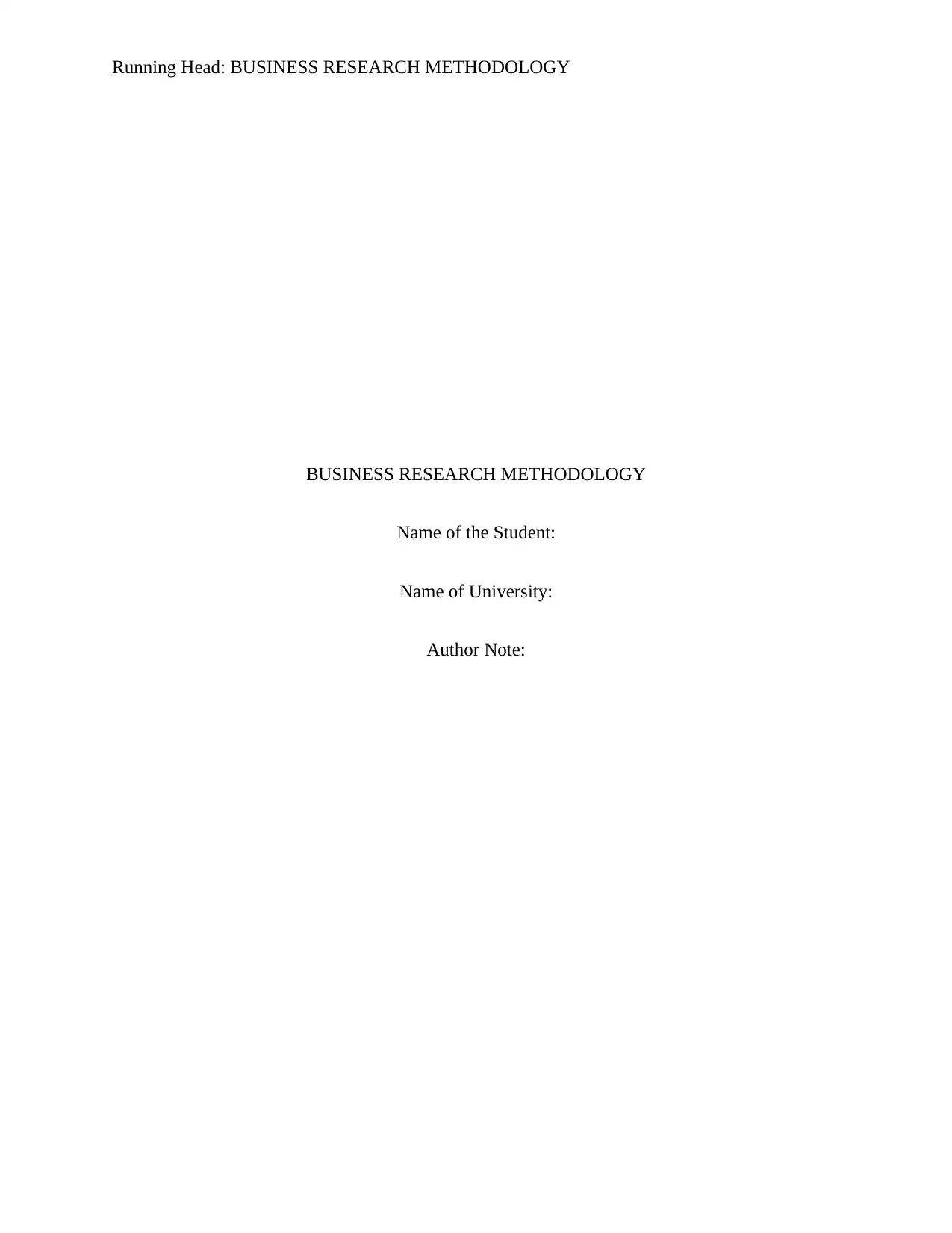
Running Head: BUSINESS RESEARCH METHODOLOGY
BUSINESS RESEARCH METHODOLOGY
Name of the Student:
Name of University:
Author Note:
BUSINESS RESEARCH METHODOLOGY
Name of the Student:
Name of University:
Author Note:
Paraphrase This Document
Need a fresh take? Get an instant paraphrase of this document with our AI Paraphraser
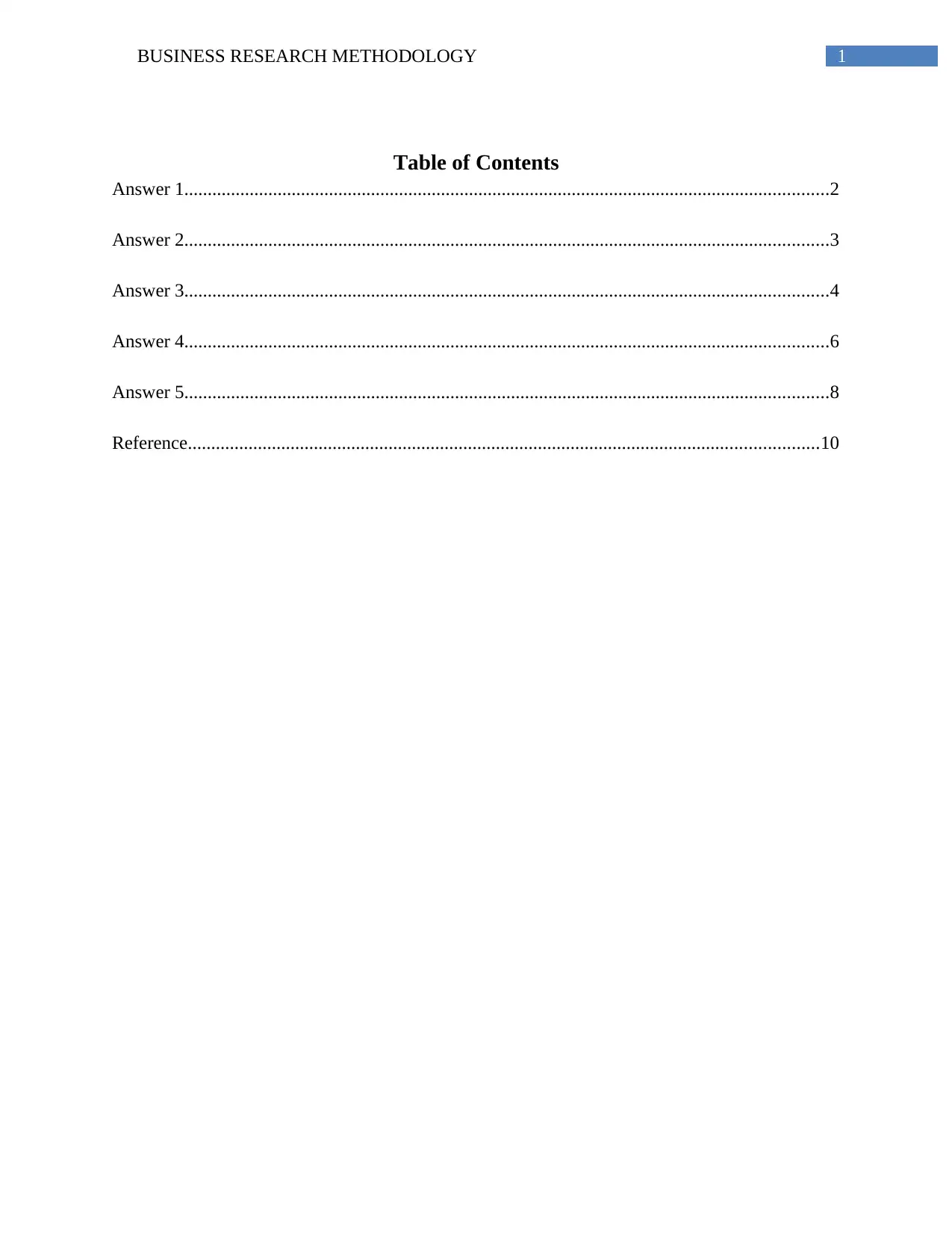
1BUSINESS RESEARCH METHODOLOGY
Table of Contents
Answer 1..........................................................................................................................................2
Answer 2..........................................................................................................................................3
Answer 3..........................................................................................................................................4
Answer 4..........................................................................................................................................6
Answer 5..........................................................................................................................................8
Reference.......................................................................................................................................10
Table of Contents
Answer 1..........................................................................................................................................2
Answer 2..........................................................................................................................................3
Answer 3..........................................................................................................................................4
Answer 4..........................................................................................................................................6
Answer 5..........................................................................................................................................8
Reference.......................................................................................................................................10
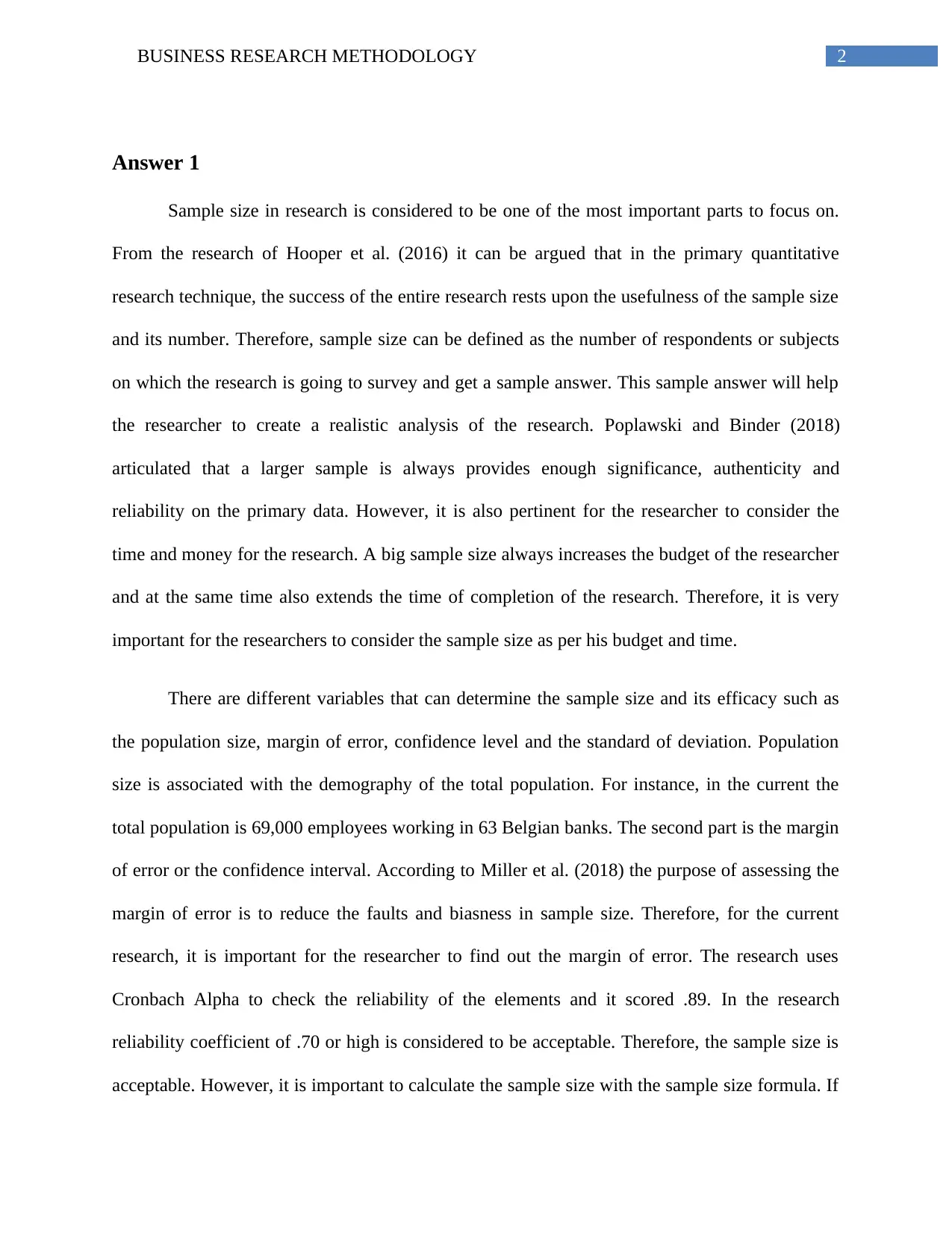
2BUSINESS RESEARCH METHODOLOGY
Answer 1
Sample size in research is considered to be one of the most important parts to focus on.
From the research of Hooper et al. (2016) it can be argued that in the primary quantitative
research technique, the success of the entire research rests upon the usefulness of the sample size
and its number. Therefore, sample size can be defined as the number of respondents or subjects
on which the research is going to survey and get a sample answer. This sample answer will help
the researcher to create a realistic analysis of the research. Poplawski and Binder (2018)
articulated that a larger sample is always provides enough significance, authenticity and
reliability on the primary data. However, it is also pertinent for the researcher to consider the
time and money for the research. A big sample size always increases the budget of the researcher
and at the same time also extends the time of completion of the research. Therefore, it is very
important for the researchers to consider the sample size as per his budget and time.
There are different variables that can determine the sample size and its efficacy such as
the population size, margin of error, confidence level and the standard of deviation. Population
size is associated with the demography of the total population. For instance, in the current the
total population is 69,000 employees working in 63 Belgian banks. The second part is the margin
of error or the confidence interval. According to Miller et al. (2018) the purpose of assessing the
margin of error is to reduce the faults and biasness in sample size. Therefore, for the current
research, it is important for the researcher to find out the margin of error. The research uses
Cronbach Alpha to check the reliability of the elements and it scored .89. In the research
reliability coefficient of .70 or high is considered to be acceptable. Therefore, the sample size is
acceptable. However, it is important to calculate the sample size with the sample size formula. If
Answer 1
Sample size in research is considered to be one of the most important parts to focus on.
From the research of Hooper et al. (2016) it can be argued that in the primary quantitative
research technique, the success of the entire research rests upon the usefulness of the sample size
and its number. Therefore, sample size can be defined as the number of respondents or subjects
on which the research is going to survey and get a sample answer. This sample answer will help
the researcher to create a realistic analysis of the research. Poplawski and Binder (2018)
articulated that a larger sample is always provides enough significance, authenticity and
reliability on the primary data. However, it is also pertinent for the researcher to consider the
time and money for the research. A big sample size always increases the budget of the researcher
and at the same time also extends the time of completion of the research. Therefore, it is very
important for the researchers to consider the sample size as per his budget and time.
There are different variables that can determine the sample size and its efficacy such as
the population size, margin of error, confidence level and the standard of deviation. Population
size is associated with the demography of the total population. For instance, in the current the
total population is 69,000 employees working in 63 Belgian banks. The second part is the margin
of error or the confidence interval. According to Miller et al. (2018) the purpose of assessing the
margin of error is to reduce the faults and biasness in sample size. Therefore, for the current
research, it is important for the researcher to find out the margin of error. The research uses
Cronbach Alpha to check the reliability of the elements and it scored .89. In the research
reliability coefficient of .70 or high is considered to be acceptable. Therefore, the sample size is
acceptable. However, it is important to calculate the sample size with the sample size formula. If
⊘ This is a preview!⊘
Do you want full access?
Subscribe today to unlock all pages.

Trusted by 1+ million students worldwide
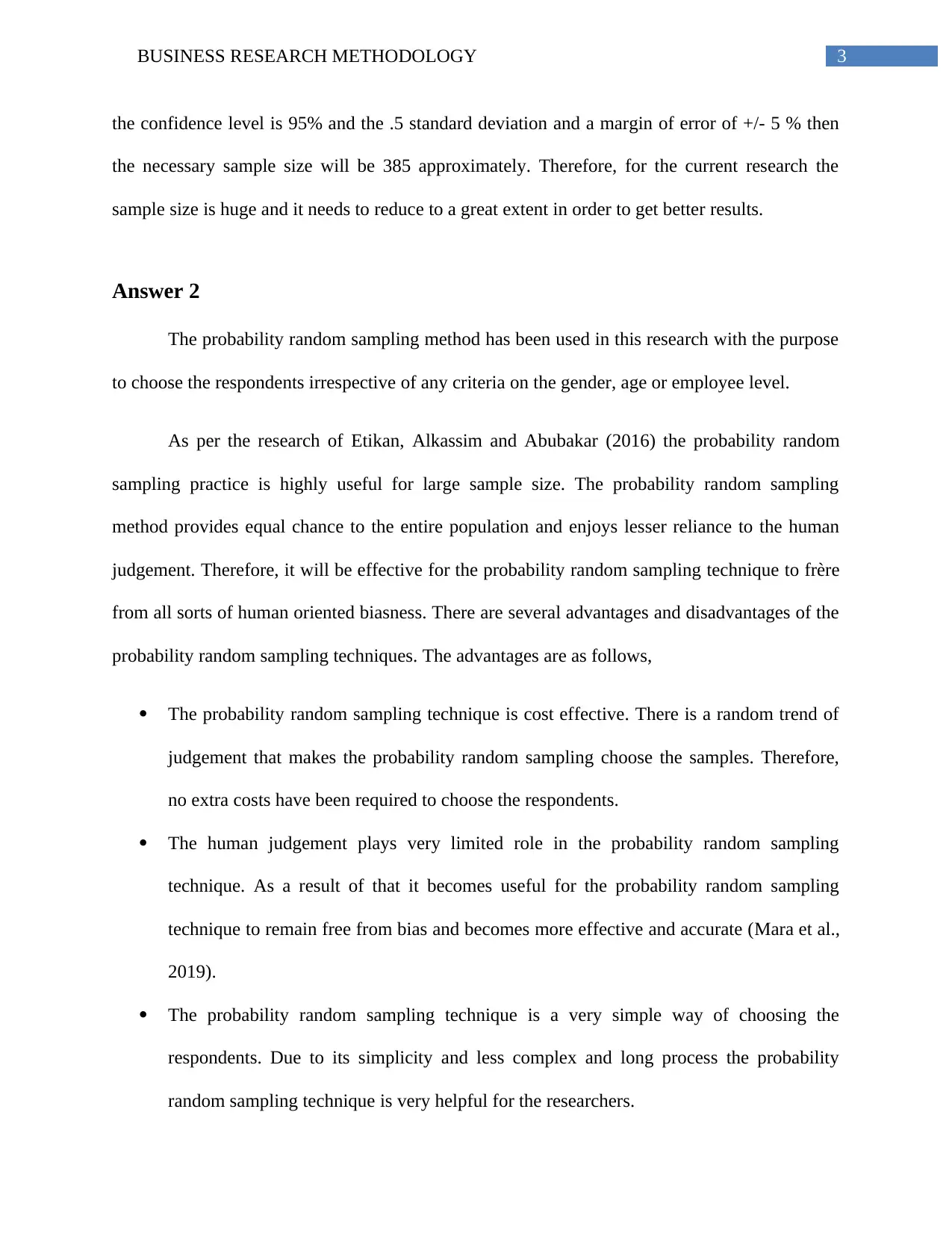
3BUSINESS RESEARCH METHODOLOGY
the confidence level is 95% and the .5 standard deviation and a margin of error of +/- 5 % then
the necessary sample size will be 385 approximately. Therefore, for the current research the
sample size is huge and it needs to reduce to a great extent in order to get better results.
Answer 2
The probability random sampling method has been used in this research with the purpose
to choose the respondents irrespective of any criteria on the gender, age or employee level.
As per the research of Etikan, Alkassim and Abubakar (2016) the probability random
sampling practice is highly useful for large sample size. The probability random sampling
method provides equal chance to the entire population and enjoys lesser reliance to the human
judgement. Therefore, it will be effective for the probability random sampling technique to frère
from all sorts of human oriented biasness. There are several advantages and disadvantages of the
probability random sampling techniques. The advantages are as follows,
The probability random sampling technique is cost effective. There is a random trend of
judgement that makes the probability random sampling choose the samples. Therefore,
no extra costs have been required to choose the respondents.
The human judgement plays very limited role in the probability random sampling
technique. As a result of that it becomes useful for the probability random sampling
technique to remain free from bias and becomes more effective and accurate (Mara et al.,
2019).
The probability random sampling technique is a very simple way of choosing the
respondents. Due to its simplicity and less complex and long process the probability
random sampling technique is very helpful for the researchers.
the confidence level is 95% and the .5 standard deviation and a margin of error of +/- 5 % then
the necessary sample size will be 385 approximately. Therefore, for the current research the
sample size is huge and it needs to reduce to a great extent in order to get better results.
Answer 2
The probability random sampling method has been used in this research with the purpose
to choose the respondents irrespective of any criteria on the gender, age or employee level.
As per the research of Etikan, Alkassim and Abubakar (2016) the probability random
sampling practice is highly useful for large sample size. The probability random sampling
method provides equal chance to the entire population and enjoys lesser reliance to the human
judgement. Therefore, it will be effective for the probability random sampling technique to frère
from all sorts of human oriented biasness. There are several advantages and disadvantages of the
probability random sampling techniques. The advantages are as follows,
The probability random sampling technique is cost effective. There is a random trend of
judgement that makes the probability random sampling choose the samples. Therefore,
no extra costs have been required to choose the respondents.
The human judgement plays very limited role in the probability random sampling
technique. As a result of that it becomes useful for the probability random sampling
technique to remain free from bias and becomes more effective and accurate (Mara et al.,
2019).
The probability random sampling technique is a very simple way of choosing the
respondents. Due to its simplicity and less complex and long process the probability
random sampling technique is very helpful for the researchers.
Paraphrase This Document
Need a fresh take? Get an instant paraphrase of this document with our AI Paraphraser
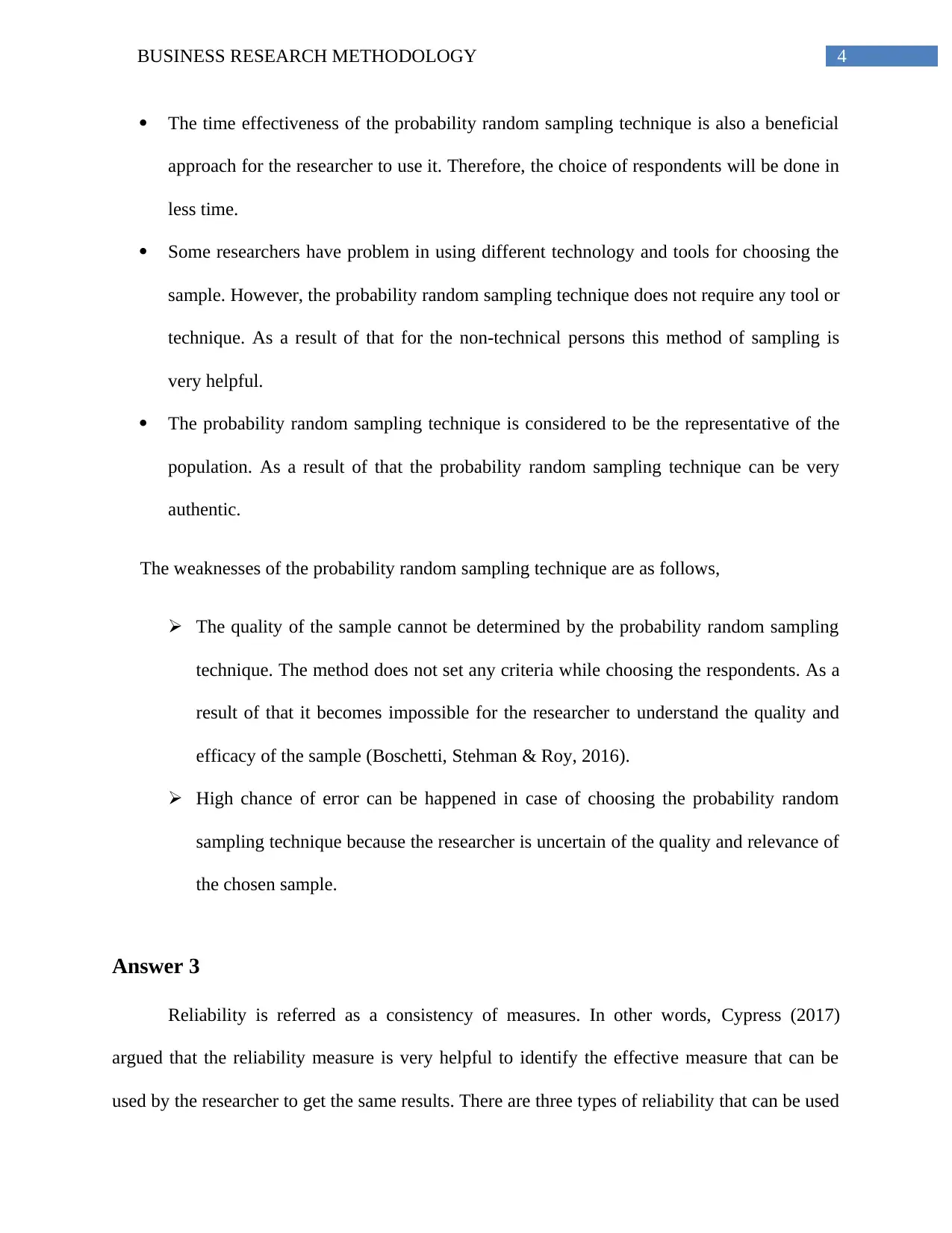
4BUSINESS RESEARCH METHODOLOGY
The time effectiveness of the probability random sampling technique is also a beneficial
approach for the researcher to use it. Therefore, the choice of respondents will be done in
less time.
Some researchers have problem in using different technology and tools for choosing the
sample. However, the probability random sampling technique does not require any tool or
technique. As a result of that for the non-technical persons this method of sampling is
very helpful.
The probability random sampling technique is considered to be the representative of the
population. As a result of that the probability random sampling technique can be very
authentic.
The weaknesses of the probability random sampling technique are as follows,
The quality of the sample cannot be determined by the probability random sampling
technique. The method does not set any criteria while choosing the respondents. As a
result of that it becomes impossible for the researcher to understand the quality and
efficacy of the sample (Boschetti, Stehman & Roy, 2016).
High chance of error can be happened in case of choosing the probability random
sampling technique because the researcher is uncertain of the quality and relevance of
the chosen sample.
Answer 3
Reliability is referred as a consistency of measures. In other words, Cypress (2017)
argued that the reliability measure is very helpful to identify the effective measure that can be
used by the researcher to get the same results. There are three types of reliability that can be used
The time effectiveness of the probability random sampling technique is also a beneficial
approach for the researcher to use it. Therefore, the choice of respondents will be done in
less time.
Some researchers have problem in using different technology and tools for choosing the
sample. However, the probability random sampling technique does not require any tool or
technique. As a result of that for the non-technical persons this method of sampling is
very helpful.
The probability random sampling technique is considered to be the representative of the
population. As a result of that the probability random sampling technique can be very
authentic.
The weaknesses of the probability random sampling technique are as follows,
The quality of the sample cannot be determined by the probability random sampling
technique. The method does not set any criteria while choosing the respondents. As a
result of that it becomes impossible for the researcher to understand the quality and
efficacy of the sample (Boschetti, Stehman & Roy, 2016).
High chance of error can be happened in case of choosing the probability random
sampling technique because the researcher is uncertain of the quality and relevance of
the chosen sample.
Answer 3
Reliability is referred as a consistency of measures. In other words, Cypress (2017)
argued that the reliability measure is very helpful to identify the effective measure that can be
used by the researcher to get the same results. There are three types of reliability that can be used
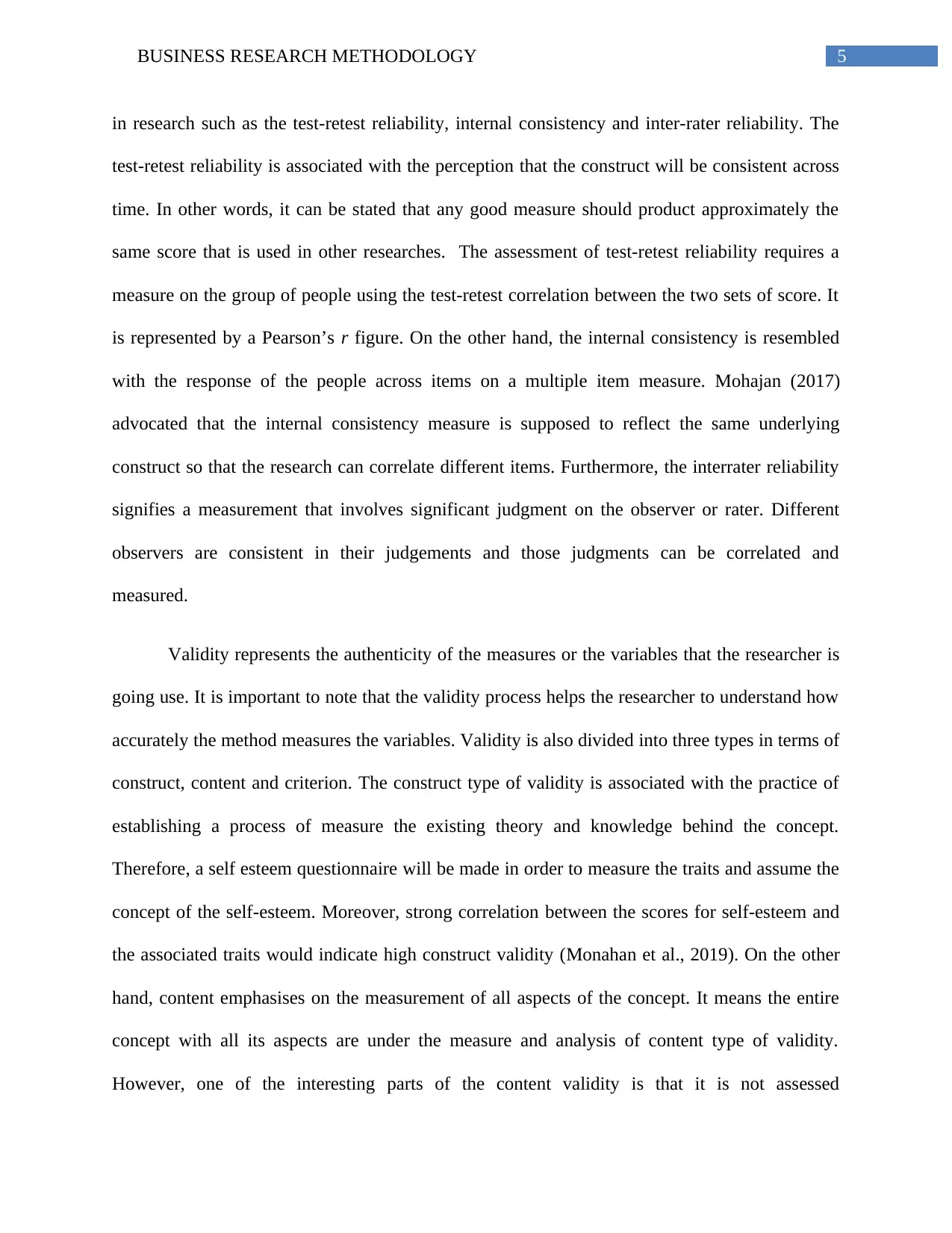
5BUSINESS RESEARCH METHODOLOGY
in research such as the test-retest reliability, internal consistency and inter-rater reliability. The
test-retest reliability is associated with the perception that the construct will be consistent across
time. In other words, it can be stated that any good measure should product approximately the
same score that is used in other researches. The assessment of test-retest reliability requires a
measure on the group of people using the test-retest correlation between the two sets of score. It
is represented by a Pearson’s r figure. On the other hand, the internal consistency is resembled
with the response of the people across items on a multiple item measure. Mohajan (2017)
advocated that the internal consistency measure is supposed to reflect the same underlying
construct so that the research can correlate different items. Furthermore, the interrater reliability
signifies a measurement that involves significant judgment on the observer or rater. Different
observers are consistent in their judgements and those judgments can be correlated and
measured.
Validity represents the authenticity of the measures or the variables that the researcher is
going use. It is important to note that the validity process helps the researcher to understand how
accurately the method measures the variables. Validity is also divided into three types in terms of
construct, content and criterion. The construct type of validity is associated with the practice of
establishing a process of measure the existing theory and knowledge behind the concept.
Therefore, a self esteem questionnaire will be made in order to measure the traits and assume the
concept of the self-esteem. Moreover, strong correlation between the scores for self-esteem and
the associated traits would indicate high construct validity (Monahan et al., 2019). On the other
hand, content emphasises on the measurement of all aspects of the concept. It means the entire
concept with all its aspects are under the measure and analysis of content type of validity.
However, one of the interesting parts of the content validity is that it is not assessed
in research such as the test-retest reliability, internal consistency and inter-rater reliability. The
test-retest reliability is associated with the perception that the construct will be consistent across
time. In other words, it can be stated that any good measure should product approximately the
same score that is used in other researches. The assessment of test-retest reliability requires a
measure on the group of people using the test-retest correlation between the two sets of score. It
is represented by a Pearson’s r figure. On the other hand, the internal consistency is resembled
with the response of the people across items on a multiple item measure. Mohajan (2017)
advocated that the internal consistency measure is supposed to reflect the same underlying
construct so that the research can correlate different items. Furthermore, the interrater reliability
signifies a measurement that involves significant judgment on the observer or rater. Different
observers are consistent in their judgements and those judgments can be correlated and
measured.
Validity represents the authenticity of the measures or the variables that the researcher is
going use. It is important to note that the validity process helps the researcher to understand how
accurately the method measures the variables. Validity is also divided into three types in terms of
construct, content and criterion. The construct type of validity is associated with the practice of
establishing a process of measure the existing theory and knowledge behind the concept.
Therefore, a self esteem questionnaire will be made in order to measure the traits and assume the
concept of the self-esteem. Moreover, strong correlation between the scores for self-esteem and
the associated traits would indicate high construct validity (Monahan et al., 2019). On the other
hand, content emphasises on the measurement of all aspects of the concept. It means the entire
concept with all its aspects are under the measure and analysis of content type of validity.
However, one of the interesting parts of the content validity is that it is not assessed
⊘ This is a preview!⊘
Do you want full access?
Subscribe today to unlock all pages.

Trusted by 1+ million students worldwide
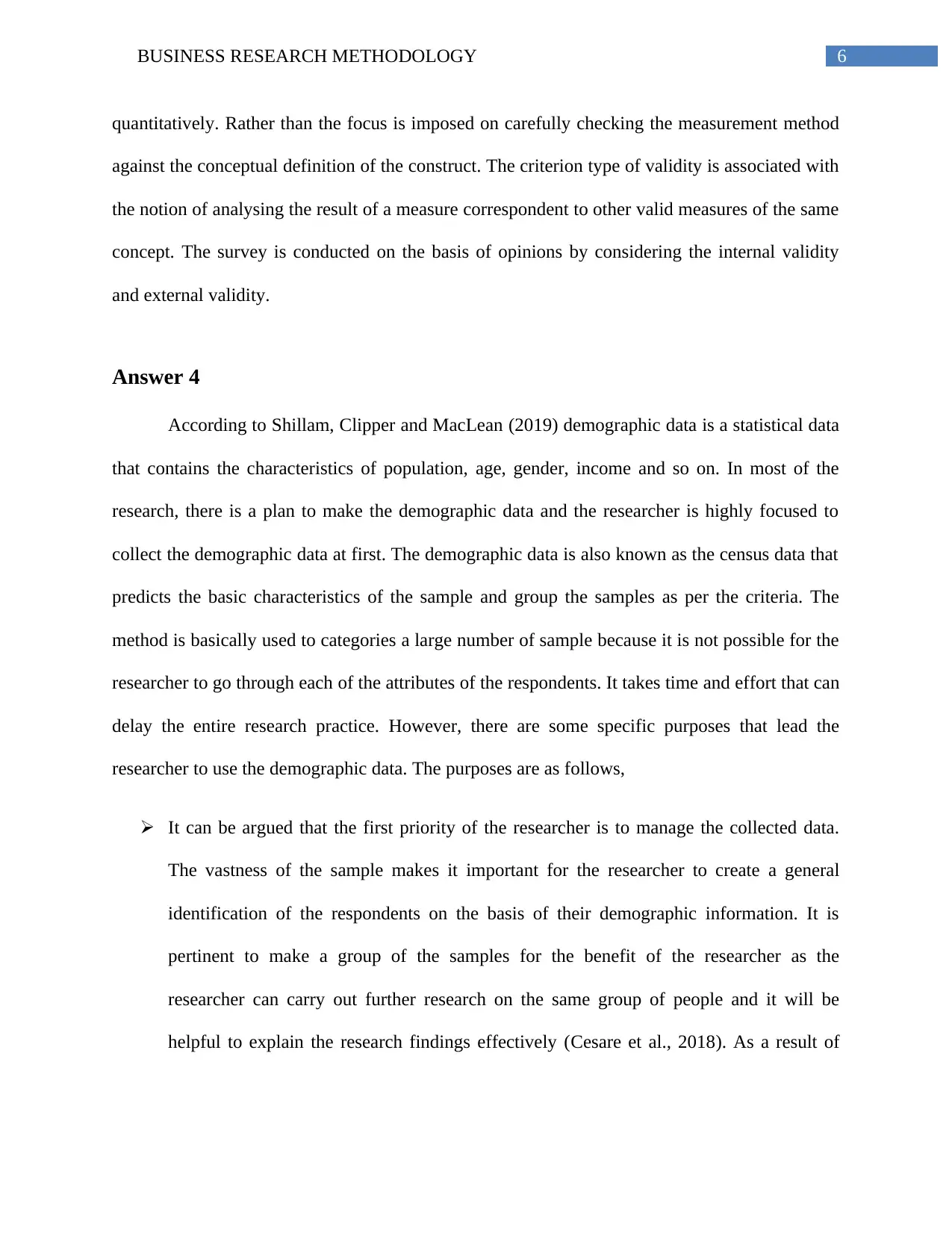
6BUSINESS RESEARCH METHODOLOGY
quantitatively. Rather than the focus is imposed on carefully checking the measurement method
against the conceptual definition of the construct. The criterion type of validity is associated with
the notion of analysing the result of a measure correspondent to other valid measures of the same
concept. The survey is conducted on the basis of opinions by considering the internal validity
and external validity.
Answer 4
According to Shillam, Clipper and MacLean (2019) demographic data is a statistical data
that contains the characteristics of population, age, gender, income and so on. In most of the
research, there is a plan to make the demographic data and the researcher is highly focused to
collect the demographic data at first. The demographic data is also known as the census data that
predicts the basic characteristics of the sample and group the samples as per the criteria. The
method is basically used to categories a large number of sample because it is not possible for the
researcher to go through each of the attributes of the respondents. It takes time and effort that can
delay the entire research practice. However, there are some specific purposes that lead the
researcher to use the demographic data. The purposes are as follows,
It can be argued that the first priority of the researcher is to manage the collected data.
The vastness of the sample makes it important for the researcher to create a general
identification of the respondents on the basis of their demographic information. It is
pertinent to make a group of the samples for the benefit of the researcher as the
researcher can carry out further research on the same group of people and it will be
helpful to explain the research findings effectively (Cesare et al., 2018). As a result of
quantitatively. Rather than the focus is imposed on carefully checking the measurement method
against the conceptual definition of the construct. The criterion type of validity is associated with
the notion of analysing the result of a measure correspondent to other valid measures of the same
concept. The survey is conducted on the basis of opinions by considering the internal validity
and external validity.
Answer 4
According to Shillam, Clipper and MacLean (2019) demographic data is a statistical data
that contains the characteristics of population, age, gender, income and so on. In most of the
research, there is a plan to make the demographic data and the researcher is highly focused to
collect the demographic data at first. The demographic data is also known as the census data that
predicts the basic characteristics of the sample and group the samples as per the criteria. The
method is basically used to categories a large number of sample because it is not possible for the
researcher to go through each of the attributes of the respondents. It takes time and effort that can
delay the entire research practice. However, there are some specific purposes that lead the
researcher to use the demographic data. The purposes are as follows,
It can be argued that the first priority of the researcher is to manage the collected data.
The vastness of the sample makes it important for the researcher to create a general
identification of the respondents on the basis of their demographic information. It is
pertinent to make a group of the samples for the benefit of the researcher as the
researcher can carry out further research on the same group of people and it will be
helpful to explain the research findings effectively (Cesare et al., 2018). As a result of
Paraphrase This Document
Need a fresh take? Get an instant paraphrase of this document with our AI Paraphraser
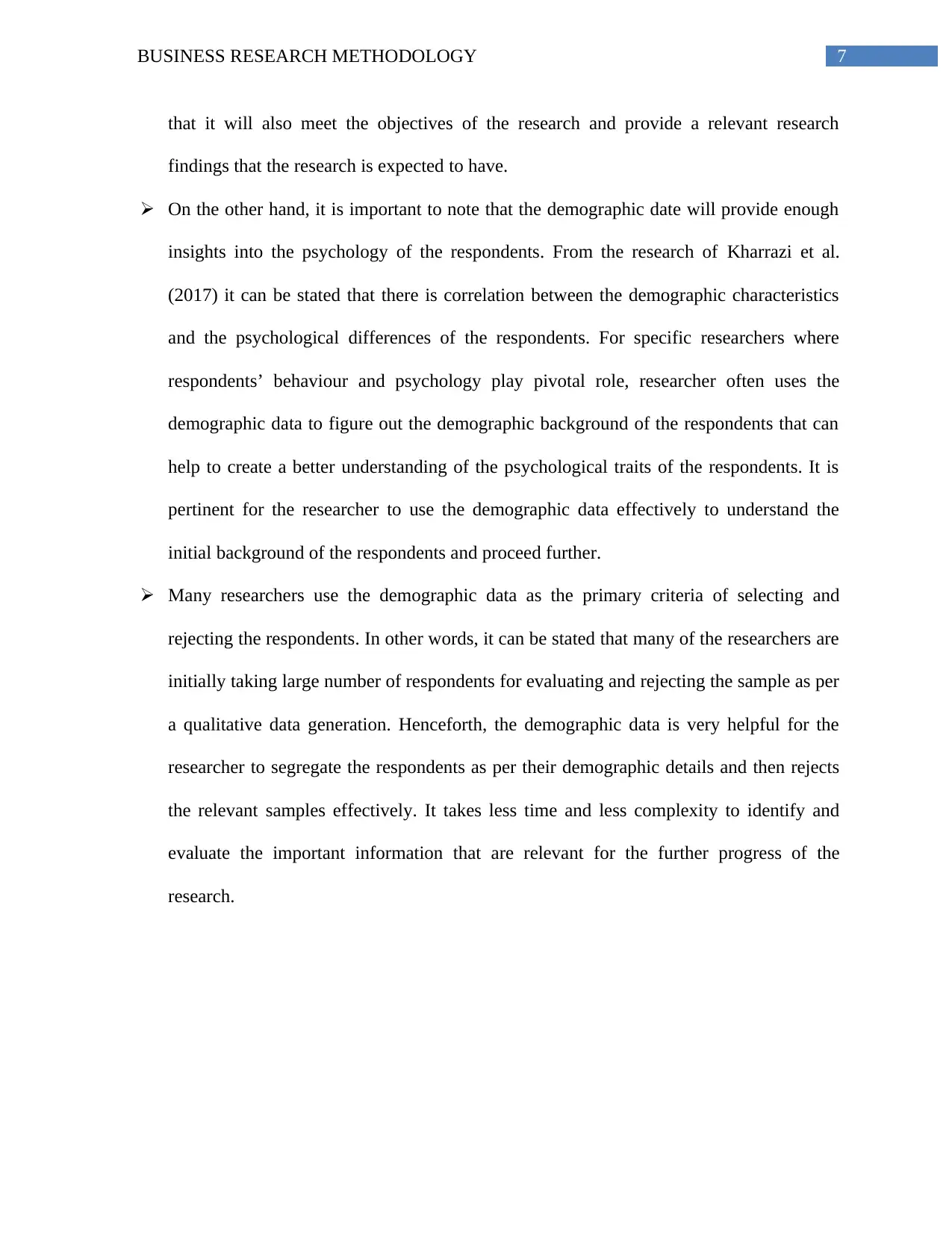
7BUSINESS RESEARCH METHODOLOGY
that it will also meet the objectives of the research and provide a relevant research
findings that the research is expected to have.
On the other hand, it is important to note that the demographic date will provide enough
insights into the psychology of the respondents. From the research of Kharrazi et al.
(2017) it can be stated that there is correlation between the demographic characteristics
and the psychological differences of the respondents. For specific researchers where
respondents’ behaviour and psychology play pivotal role, researcher often uses the
demographic data to figure out the demographic background of the respondents that can
help to create a better understanding of the psychological traits of the respondents. It is
pertinent for the researcher to use the demographic data effectively to understand the
initial background of the respondents and proceed further.
Many researchers use the demographic data as the primary criteria of selecting and
rejecting the respondents. In other words, it can be stated that many of the researchers are
initially taking large number of respondents for evaluating and rejecting the sample as per
a qualitative data generation. Henceforth, the demographic data is very helpful for the
researcher to segregate the respondents as per their demographic details and then rejects
the relevant samples effectively. It takes less time and less complexity to identify and
evaluate the important information that are relevant for the further progress of the
research.
that it will also meet the objectives of the research and provide a relevant research
findings that the research is expected to have.
On the other hand, it is important to note that the demographic date will provide enough
insights into the psychology of the respondents. From the research of Kharrazi et al.
(2017) it can be stated that there is correlation between the demographic characteristics
and the psychological differences of the respondents. For specific researchers where
respondents’ behaviour and psychology play pivotal role, researcher often uses the
demographic data to figure out the demographic background of the respondents that can
help to create a better understanding of the psychological traits of the respondents. It is
pertinent for the researcher to use the demographic data effectively to understand the
initial background of the respondents and proceed further.
Many researchers use the demographic data as the primary criteria of selecting and
rejecting the respondents. In other words, it can be stated that many of the researchers are
initially taking large number of respondents for evaluating and rejecting the sample as per
a qualitative data generation. Henceforth, the demographic data is very helpful for the
researcher to segregate the respondents as per their demographic details and then rejects
the relevant samples effectively. It takes less time and less complexity to identify and
evaluate the important information that are relevant for the further progress of the
research.
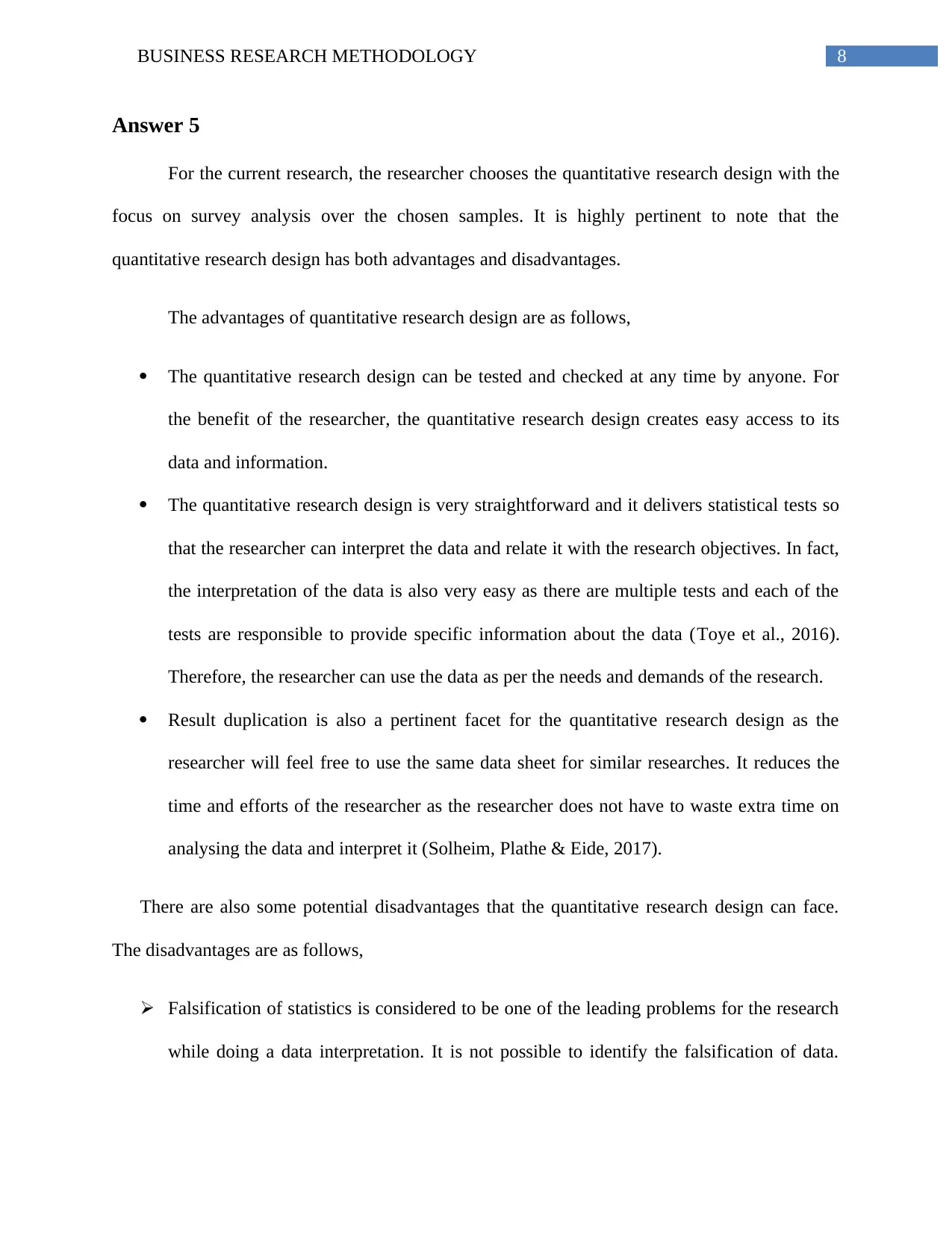
8BUSINESS RESEARCH METHODOLOGY
Answer 5
For the current research, the researcher chooses the quantitative research design with the
focus on survey analysis over the chosen samples. It is highly pertinent to note that the
quantitative research design has both advantages and disadvantages.
The advantages of quantitative research design are as follows,
The quantitative research design can be tested and checked at any time by anyone. For
the benefit of the researcher, the quantitative research design creates easy access to its
data and information.
The quantitative research design is very straightforward and it delivers statistical tests so
that the researcher can interpret the data and relate it with the research objectives. In fact,
the interpretation of the data is also very easy as there are multiple tests and each of the
tests are responsible to provide specific information about the data (Toye et al., 2016).
Therefore, the researcher can use the data as per the needs and demands of the research.
Result duplication is also a pertinent facet for the quantitative research design as the
researcher will feel free to use the same data sheet for similar researches. It reduces the
time and efforts of the researcher as the researcher does not have to waste extra time on
analysing the data and interpret it (Solheim, Plathe & Eide, 2017).
There are also some potential disadvantages that the quantitative research design can face.
The disadvantages are as follows,
Falsification of statistics is considered to be one of the leading problems for the research
while doing a data interpretation. It is not possible to identify the falsification of data.
Answer 5
For the current research, the researcher chooses the quantitative research design with the
focus on survey analysis over the chosen samples. It is highly pertinent to note that the
quantitative research design has both advantages and disadvantages.
The advantages of quantitative research design are as follows,
The quantitative research design can be tested and checked at any time by anyone. For
the benefit of the researcher, the quantitative research design creates easy access to its
data and information.
The quantitative research design is very straightforward and it delivers statistical tests so
that the researcher can interpret the data and relate it with the research objectives. In fact,
the interpretation of the data is also very easy as there are multiple tests and each of the
tests are responsible to provide specific information about the data (Toye et al., 2016).
Therefore, the researcher can use the data as per the needs and demands of the research.
Result duplication is also a pertinent facet for the quantitative research design as the
researcher will feel free to use the same data sheet for similar researches. It reduces the
time and efforts of the researcher as the researcher does not have to waste extra time on
analysing the data and interpret it (Solheim, Plathe & Eide, 2017).
There are also some potential disadvantages that the quantitative research design can face.
The disadvantages are as follows,
Falsification of statistics is considered to be one of the leading problems for the research
while doing a data interpretation. It is not possible to identify the falsification of data.
⊘ This is a preview!⊘
Do you want full access?
Subscribe today to unlock all pages.

Trusted by 1+ million students worldwide
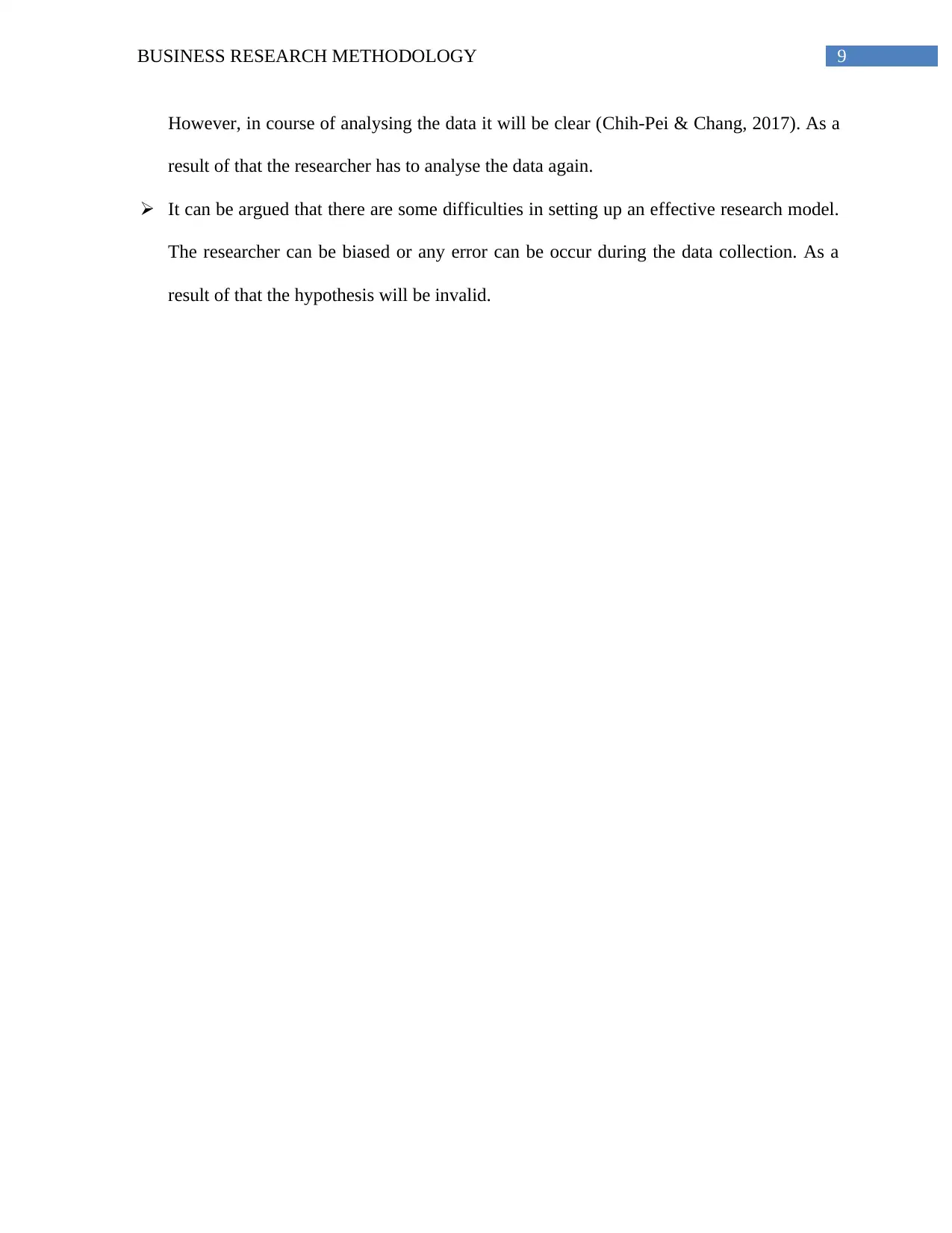
9BUSINESS RESEARCH METHODOLOGY
However, in course of analysing the data it will be clear (Chih-Pei & Chang, 2017). As a
result of that the researcher has to analyse the data again.
It can be argued that there are some difficulties in setting up an effective research model.
The researcher can be biased or any error can be occur during the data collection. As a
result of that the hypothesis will be invalid.
However, in course of analysing the data it will be clear (Chih-Pei & Chang, 2017). As a
result of that the researcher has to analyse the data again.
It can be argued that there are some difficulties in setting up an effective research model.
The researcher can be biased or any error can be occur during the data collection. As a
result of that the hypothesis will be invalid.
Paraphrase This Document
Need a fresh take? Get an instant paraphrase of this document with our AI Paraphraser
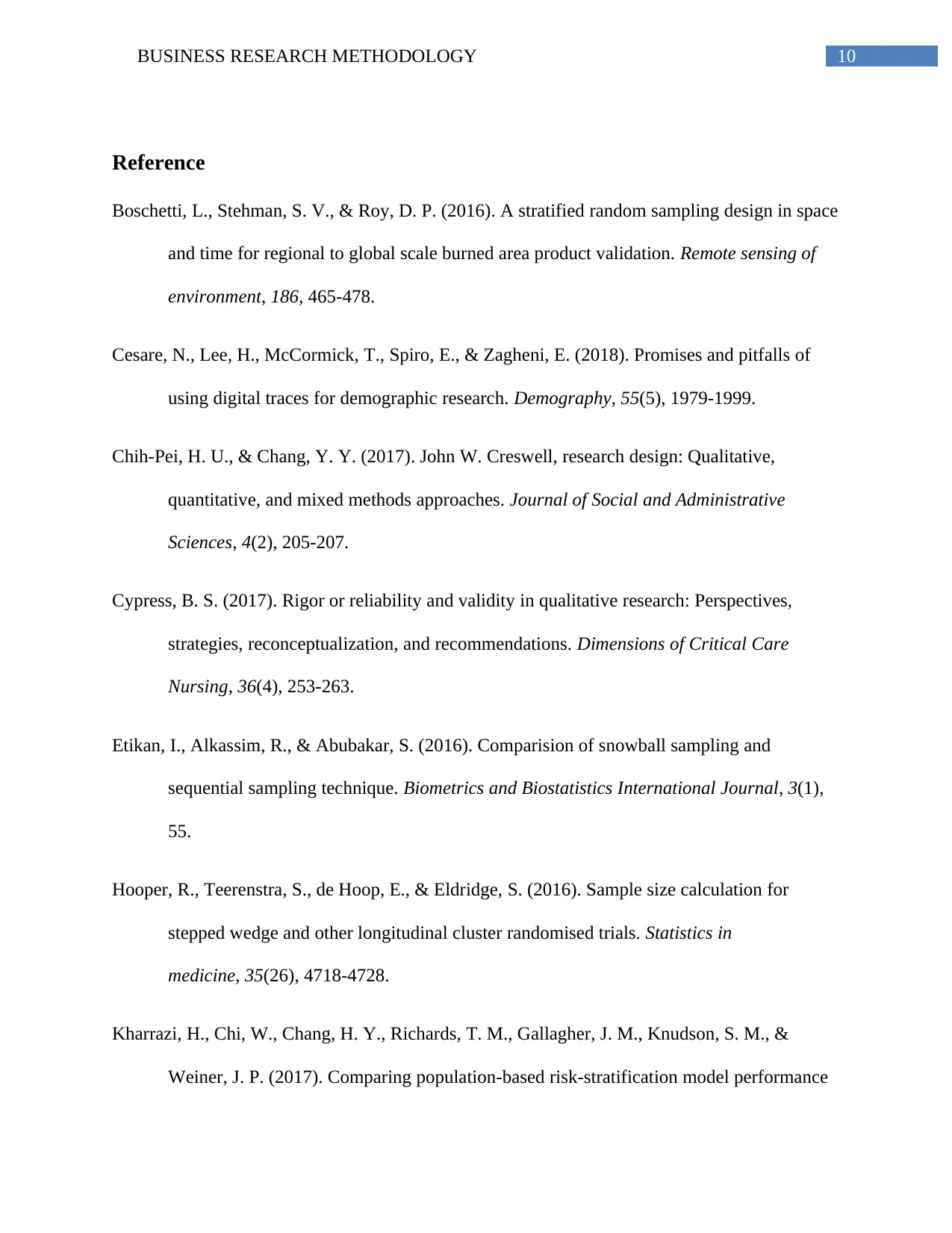
10BUSINESS RESEARCH METHODOLOGY
Reference
Boschetti, L., Stehman, S. V., & Roy, D. P. (2016). A stratified random sampling design in space
and time for regional to global scale burned area product validation. Remote sensing of
environment, 186, 465-478.
Cesare, N., Lee, H., McCormick, T., Spiro, E., & Zagheni, E. (2018). Promises and pitfalls of
using digital traces for demographic research. Demography, 55(5), 1979-1999.
Chih-Pei, H. U., & Chang, Y. Y. (2017). John W. Creswell, research design: Qualitative,
quantitative, and mixed methods approaches. Journal of Social and Administrative
Sciences, 4(2), 205-207.
Cypress, B. S. (2017). Rigor or reliability and validity in qualitative research: Perspectives,
strategies, reconceptualization, and recommendations. Dimensions of Critical Care
Nursing, 36(4), 253-263.
Etikan, I., Alkassim, R., & Abubakar, S. (2016). Comparision of snowball sampling and
sequential sampling technique. Biometrics and Biostatistics International Journal, 3(1),
55.
Hooper, R., Teerenstra, S., de Hoop, E., & Eldridge, S. (2016). Sample size calculation for
stepped wedge and other longitudinal cluster randomised trials. Statistics in
medicine, 35(26), 4718-4728.
Kharrazi, H., Chi, W., Chang, H. Y., Richards, T. M., Gallagher, J. M., Knudson, S. M., &
Weiner, J. P. (2017). Comparing population-based risk-stratification model performance
Reference
Boschetti, L., Stehman, S. V., & Roy, D. P. (2016). A stratified random sampling design in space
and time for regional to global scale burned area product validation. Remote sensing of
environment, 186, 465-478.
Cesare, N., Lee, H., McCormick, T., Spiro, E., & Zagheni, E. (2018). Promises and pitfalls of
using digital traces for demographic research. Demography, 55(5), 1979-1999.
Chih-Pei, H. U., & Chang, Y. Y. (2017). John W. Creswell, research design: Qualitative,
quantitative, and mixed methods approaches. Journal of Social and Administrative
Sciences, 4(2), 205-207.
Cypress, B. S. (2017). Rigor or reliability and validity in qualitative research: Perspectives,
strategies, reconceptualization, and recommendations. Dimensions of Critical Care
Nursing, 36(4), 253-263.
Etikan, I., Alkassim, R., & Abubakar, S. (2016). Comparision of snowball sampling and
sequential sampling technique. Biometrics and Biostatistics International Journal, 3(1),
55.
Hooper, R., Teerenstra, S., de Hoop, E., & Eldridge, S. (2016). Sample size calculation for
stepped wedge and other longitudinal cluster randomised trials. Statistics in
medicine, 35(26), 4718-4728.
Kharrazi, H., Chi, W., Chang, H. Y., Richards, T. M., Gallagher, J. M., Knudson, S. M., &
Weiner, J. P. (2017). Comparing population-based risk-stratification model performance
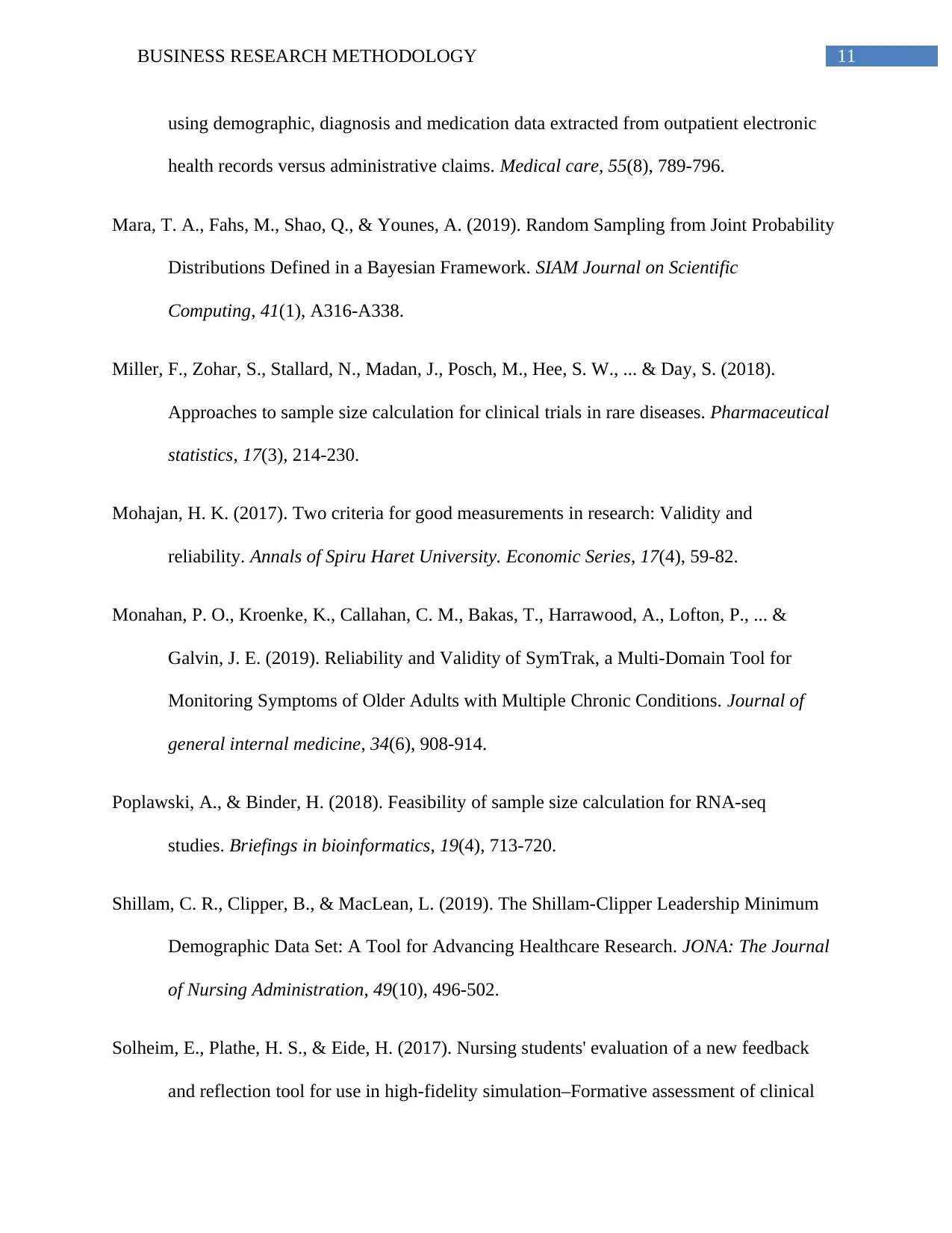
11BUSINESS RESEARCH METHODOLOGY
using demographic, diagnosis and medication data extracted from outpatient electronic
health records versus administrative claims. Medical care, 55(8), 789-796.
Mara, T. A., Fahs, M., Shao, Q., & Younes, A. (2019). Random Sampling from Joint Probability
Distributions Defined in a Bayesian Framework. SIAM Journal on Scientific
Computing, 41(1), A316-A338.
Miller, F., Zohar, S., Stallard, N., Madan, J., Posch, M., Hee, S. W., ... & Day, S. (2018).
Approaches to sample size calculation for clinical trials in rare diseases. Pharmaceutical
statistics, 17(3), 214-230.
Mohajan, H. K. (2017). Two criteria for good measurements in research: Validity and
reliability. Annals of Spiru Haret University. Economic Series, 17(4), 59-82.
Monahan, P. O., Kroenke, K., Callahan, C. M., Bakas, T., Harrawood, A., Lofton, P., ... &
Galvin, J. E. (2019). Reliability and Validity of SymTrak, a Multi-Domain Tool for
Monitoring Symptoms of Older Adults with Multiple Chronic Conditions. Journal of
general internal medicine, 34(6), 908-914.
Poplawski, A., & Binder, H. (2018). Feasibility of sample size calculation for RNA-seq
studies. Briefings in bioinformatics, 19(4), 713-720.
Shillam, C. R., Clipper, B., & MacLean, L. (2019). The Shillam-Clipper Leadership Minimum
Demographic Data Set: A Tool for Advancing Healthcare Research. JONA: The Journal
of Nursing Administration, 49(10), 496-502.
Solheim, E., Plathe, H. S., & Eide, H. (2017). Nursing students' evaluation of a new feedback
and reflection tool for use in high-fidelity simulation–Formative assessment of clinical
using demographic, diagnosis and medication data extracted from outpatient electronic
health records versus administrative claims. Medical care, 55(8), 789-796.
Mara, T. A., Fahs, M., Shao, Q., & Younes, A. (2019). Random Sampling from Joint Probability
Distributions Defined in a Bayesian Framework. SIAM Journal on Scientific
Computing, 41(1), A316-A338.
Miller, F., Zohar, S., Stallard, N., Madan, J., Posch, M., Hee, S. W., ... & Day, S. (2018).
Approaches to sample size calculation for clinical trials in rare diseases. Pharmaceutical
statistics, 17(3), 214-230.
Mohajan, H. K. (2017). Two criteria for good measurements in research: Validity and
reliability. Annals of Spiru Haret University. Economic Series, 17(4), 59-82.
Monahan, P. O., Kroenke, K., Callahan, C. M., Bakas, T., Harrawood, A., Lofton, P., ... &
Galvin, J. E. (2019). Reliability and Validity of SymTrak, a Multi-Domain Tool for
Monitoring Symptoms of Older Adults with Multiple Chronic Conditions. Journal of
general internal medicine, 34(6), 908-914.
Poplawski, A., & Binder, H. (2018). Feasibility of sample size calculation for RNA-seq
studies. Briefings in bioinformatics, 19(4), 713-720.
Shillam, C. R., Clipper, B., & MacLean, L. (2019). The Shillam-Clipper Leadership Minimum
Demographic Data Set: A Tool for Advancing Healthcare Research. JONA: The Journal
of Nursing Administration, 49(10), 496-502.
Solheim, E., Plathe, H. S., & Eide, H. (2017). Nursing students' evaluation of a new feedback
and reflection tool for use in high-fidelity simulation–Formative assessment of clinical
⊘ This is a preview!⊘
Do you want full access?
Subscribe today to unlock all pages.

Trusted by 1+ million students worldwide
1 out of 13
Related Documents
Your All-in-One AI-Powered Toolkit for Academic Success.
+13062052269
info@desklib.com
Available 24*7 on WhatsApp / Email
![[object Object]](/_next/static/media/star-bottom.7253800d.svg)
Unlock your academic potential
Copyright © 2020–2025 A2Z Services. All Rights Reserved. Developed and managed by ZUCOL.





